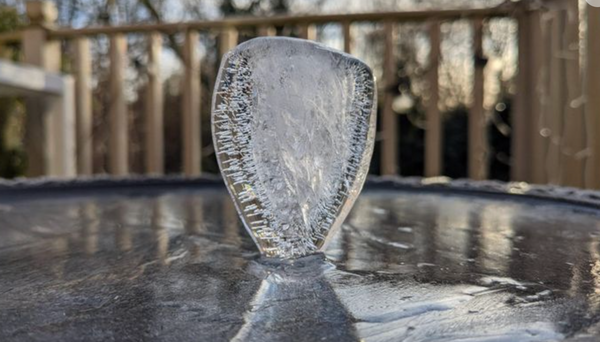There is something so alluring about witnessing rare natural phenomena. Perhaps it’s the sense of awe and wonder they evoke, or the knowledge that these events are fleeting and can only be seen at a certain time of year.
Here are twelve natural wonders that you can only see during specific months. Who knows, maybe you’ll find a new favorite spot.
1. January: Frozen bubbles under Lake Abraham

Lake Abraham is a popular summer spot for fishing, swimming, and ice skating. But did you know it’s also a great place to see frozen bubbles? Under the right conditions, the bubbles below the lake's surface can turn into beautiful works of art.
Location: Lake Abraham, Alberta, Canada
Time: December — February
2. February: Yosemite Horsetail Firefall

If you’re visiting Yosemite National Park anytime soon, be sure to check out the Horsetail Firefall. This natural spectacle only happens for a few weeks in February, when the setting sun hits the waterfall just right and creates a fiery waterfall. It’s worth checking out!
Location: Yosemite Valley, Yosemite National Park, California, USA
Time: Second half of February
3. March: Starling murmurations

A murmuration is a group of starlings that move together in perfect synchronization. They swirl and dive through the air, creating an incredible aerial display. Watching them is mesmerizing. If you’ve never seen one before, I recommend checking it out. You won’t be disappointed.
Location: Across the UK
Time: January — March
4. April: Wisteria blooming

The wisteria in Japan is famous for its early blooming each year. The purple and white flowers can be seen dotting the trees throughout the country, adding a splash of color to an otherwise drab landscape. If you’re lucky enough to be in Japan during wisteria season, take some time to check out the beautiful sights.
Location: Across Japan
Time: mid-April — mid-May
5. May: Synchronous fireflies

Synchronous fireflies – also known as lightning bugs – are some of the most fascinating and beautiful creatures found in nature. These little insects put on a show every summer by flashing their lights in perfect synchronization. If you’re lucky enough to see them in person, it’s an amazing sight!
Location: Great Smoky Mountains National Park, USA
Time: May — June
6. June: Climbing goats

Did you know that there are goats that climb trees? It’s true! These goats, found in the hills of North Africa and the Middle East, are perfectly adapted to their environment. They have long, smooth horns that help them grip onto branches and strong hooves that give them stability when up high. Interestingly, these goats aren’t mountain goats – they descend from domesticated goats that farmers in the area kept. Over time, the wild goats evolved into better climbers, and now they can stay safe in the trees even when predators are around.
Location: Morocco
Time: June
7. July: Midnight sun

The midnight sun is a fantastic phenomenon you can see during the summers anywhere south of the Antarctic Circle and north of the Arctic Circle, and Norway is one of the places you can enjoy it. The axis of the Earth’s rotation is tilted, which causes the North Pole to be angled toward the sun in the summer. It creates an amazing effect you can only see in this area — the sun never sets for several weeks in summer.
Location: Norway
Time: June — August
8. August: Spotted Lake Osoyoos

The unique mineral composition of the water gives the lake its spotted appearance. The best time to visit is during the summer when the water is at its lowest and the most visible spots. Be sure to bring your camera – it’s a sight you won’t want to miss!
Location: British Columbia, Canada
Time: July — August
9. September: Yuncheng Salt Lake

Salt lakes are natural wonders that are found all over the world. But, there is one salt lake in China that is particularly interesting, and that is Yuncheng Salt Lake. This lake is known for its strange properties and eerie atmosphere. The waters of this Chinese lake can show the full spectrum of colors from green and yellow to scarlet and magenta. It all happens thanks to a wide range of algae blooms in the lake. The lake always looks spectacular.
Location: Yuncheng, China
Time: September — October
10. October: The liquid rainbow of Cano Cristales

Planning a trip to Colombia? Be sure to add a visit to the stunning Caño Cristales river to your itinerary! This river is famous for its brightly-colored liquid rainbow, making it an unforgettable sight. Whether you’re looking for an adventurous escape or just want to take in some amazing natural beauty, Caño Cristales is worth a visit.
Location: Colombia
Time: October — November
11. November: Flowering Atacama Desert

The Atacama Desert in Chile is one of the driest places on Earth, but during certain times of the year, it’s covered in beautiful flowers! It’s something to see. Tourists and photographers flock to this normally barren landscape to witness a rare sight, colorful wildflowers dotting the parched earth. some parts of the desert boast up to 550 different species of flowers.
Location: Chile
Time: September — November
12. December: Sailing stones

There’s a mysterious place in Death Valley where rocks move independently. No one knows how they do it, but the stones seem to sail across the desert floor, leaving trails in their wake. Some say the rocks are pushed by wind or water, but no one has been able to prove it. It’s one of nature’s great mysteries, and it continues to fascinate scientists and tourists alike. Who knows what secrets these stones could tell us if we could only figure out how they move?
Location: Death Valley, California, USA
Time: December — February
So what are you waiting for? Get out there and see some of these natural phenomena for yourself. And don’t forget to share this post with your friends. They might want to check out these amazing sights too.







